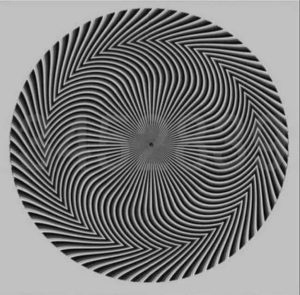Optical illusion shows hidden number – and everyone is seeing it differently

Optical illusions are known for their puzzling nature and for pushing our eyesight to its limits. As such, a particularly special one is doing the rounds on the internet presently.
It has left the majority of its viewers baffled even though it is one of the more straightforward illusions.
The Optical Illusion With A Hidden Message
Optical illusions come in many different types.
Some ask the viewer to find a mistake, while others disguise the answer in plain sight. This one is closer to the latter category.
This particular optical illusion tests the viewer’s sensitivity towards contrasting colors.
At first glance, it may seem pretty simple. However, the more you look at it, you may see more and more is revealed to you.
Of course, in the end, the actual answer is still confusing most of the viewers.

So, let’s take a look at the optical illusions first. Here it is:
Do You see a number? If so, what number?
This challenge, which has gone viral on Twitter, has done so because of its perceived simplicity. There is a number that is hidden within the striped grey and black circle. Can you see the entire number? It may seem simple, but its actually a harder test than it seems.
The illusion is actually a test for the viewer’s contrast sensitivity. It is the ability to differentiate an object from its background. In daily life, this ability is important for driving in foggy weather or when there is low light. During those times, the contrast between the background and the object is reduced.
So now that you know the focus of the optical illusion, can you spot all the digits?
Before we get to the actual answers, here are some of the answers that the viewers posted:
“I can only see 528. Does that mean anything about my eyesight?” -@CookieLousie
“I see 528 with glasses and 45283 without… I can’t read a screen without glasses however”
-@Techn0phobe -@PhilippeAuclair
45283…and what’s the catch? Should I book an appointment with my GP?
The majority of the viewers said that they could 528 or, at the most, 45283. But the real answer will shock you.
Are you ready for it? Well, then, here it is:
The actual answer is 3452839 – a whopping seven-digit number. Now, most of the people saw the numbers at the middle of the circle where the contrast was highest. As one moved away from the center, the contrast between the digits and the background diminished, which made the digits on the extreme quite difficult to see. But you can see a glimpse of them if you squint hard enough!
If you actually did manage to see them, then you have one of the best eyesight in the world. You can be proud of it! Share the optical illusion with your friends and family, and see how good their eyesight is!
These are old classic mathematical problems. When you were in middle or high school.
These tests are more fun when you find yourself trying to remember the math you learned as a child.
90% Fail to Answer This Correctly!
So now I will treat you to a math problem designed for school students. But it’s not that simple for those who graduated decades ago. It’s easy to forget the order of operations as we grow older.
The question now: Can you solve this equation?
Time to use that head of yours.
Yeah, it’s not that simple, but as I said, not even 50% get it right at first.
Now to the brainteaser – can you figure out the answer? Try to think back on the mathematical rules!
A
B
C
ANSWER:
Below, we’ll show you the answer.
You get this if you see that the ones at the end of each row have no sign between them and the next one.
Therefore, they are actually 22s.
The “2 x 0” on the last line becomes 0. Multiplication must always be solved before addition if there are no parentheses.
2+2+2+2+22+2+2+2+22+2×0+2=60.
The solution is 60.
Did you solve it correctly?
The Cognitive Benefits of Quizzes for the Human Brain
Quizzes are often associated with classrooms and game shows, but their benefits extend far beyond entertainment or academic assessment. They are powerful tools that can enhance brain function, improve memory, and promote lifelong learning. Recent research in cognitive psychology and neuroscience highlights the positive effects of quizzing on brain health and intellectual development.
One of the most significant benefits of quizzes is the testing effect. This phenomenon suggests that retrieving information from memory, as one does during a quiz, strengthens that memory more than simply re-studying the information. When individuals actively recall facts or concepts, neural connections associated with that knowledge become more robust. This improves long-term retention and makes it easier to retrieve the information in the future. In short, quizzing reinforces learning in a way that passive review does not.
Quizzes also encourage active learning. Unlike reading or listening, taking a quiz requires the learner to engage with the material, think critically, and apply knowledge. This active engagement helps the brain encode information more deeply. As a result, learners are more likely to understand and remember the content, rather than merely memorize it.
Additionally, quizzes enhance metacognition, or the awareness of one’s own knowledge and thought processes. When individuals take a quiz, they receive feedback—either immediately or afterward—that helps them evaluate what they know and what they still need to learn. This process fosters self-awareness and helps learners adjust their study strategies for more effective outcomes. Knowing which areas are weak or strong allows for targeted practice, which is crucial for skill development.
Regular quizzing can also improve attention and focus. When people expect to be tested, they are more likely to concentrate during the learning phase. This heightened attention boosts the quality of learning and helps prevent the common problem of mind-wandering. Over time, the habit of focusing in preparation for quizzes can lead to improved concentration in other areas of life as well.
Beyond the cognitive benefits, quizzes also provide emotional and motivational advantages. They offer a sense of achievement, especially when learners see progress over time. This can increase motivation, reduce anxiety around testing, and build confidence in one’s abilities. Quizzes with gamified elements, such as points or levels, can also make learning more enjoyable and engaging.
From a neurological perspective, the brain thrives on challenge and novelty—two key features of well-designed quizzes. They stimulate the brain’s reward system by offering immediate feedback and small successes, keeping the learner mentally engaged. Furthermore, regular mental challenges such as quizzes are associated with a reduced risk of cognitive decline as people age, suggesting they may even contribute to brain health over the long term.
In conclusion, quizzes are far more than academic exercises. They are dynamic cognitive tools that reinforce memory, encourage active engagement, sharpen focus, and promote self-awareness. Whether used in schools, professional training, or self-study, quizzes play a vital role in enhancing learning and maintaining a healthy, active brain.
